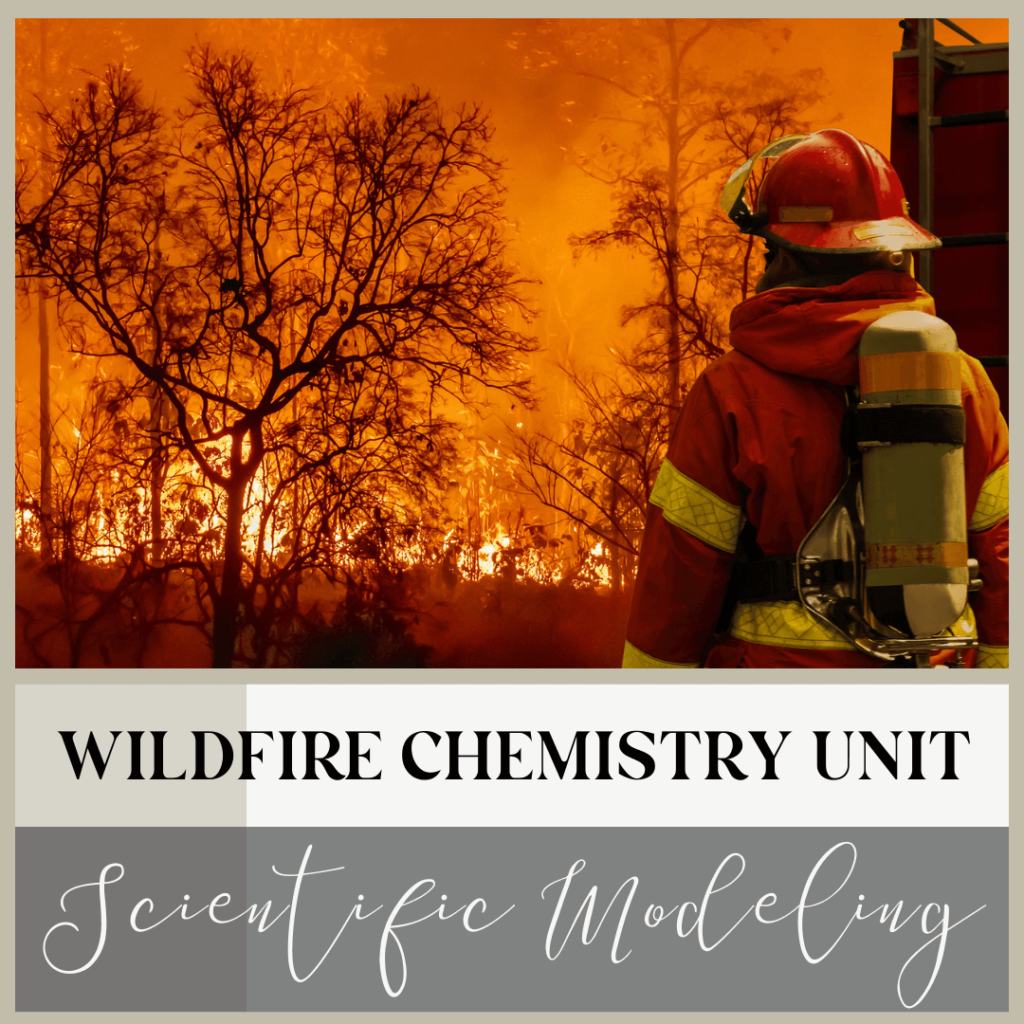Before we jump into strategies for teaching the matter conservation law, I want to start by saying, for years, I taught chemistry according to the same structure and sequence I learned as a student teacher. And I never questioned it… which meant I always waited until January before tackling the matter conservation law.
I’d like to say there was a reason I waited so long in the school year to teach the matter conservation law. Truthfully though, it was mainly because that was the sequence I learned during my formative years- and that was that.

But a few years ago, I had a big realization...
For better or worse, as teachers, it is easy to get caught up in doing the same lessons year after year- not questioning the sequencing or pacing of those lessons.
But a few years ago, I had a big realization…
While, yes, teaching matter conservation later in the year went along with the sequence I was used to, it also meant I was missing out on a unique opportunity for students to work with numbers in a way that built their confidence at the start of the year. Not to mention I was missing out on a lot of ways to further spiral that content!
This might not seem like much of a realization, but hear me out.
This tiny seed of an idea opened my eyes to something…
For years I had been pushing my students to meet the demands of a traditional chemistry curriculum.
From starting the year with difficult topics (e.g. significant figures, dimensional analysis)… to cramming in highly conceptual, loosely related content just to say, “we covered those topics” … to drilling down on nuanced terms like “colloid” and “suspension” and “Tyndall Effect” in the first weeks of school…
Yep, you name it, and I tried to make it happen as a chemistry teacher… every year and for every class.
But I started thinking to myself, what if I stopped doing all that? And changed things around?
What if, rather than pushing my students to meet the demands of the chemistry curriculum, instead, I molded the chemistry curriculum to meet the needs of my students?
This was a NEW thought.

So, how did it go, you ask?
So about 8 years into teaching chemistry, I decided to give it a shot. I made a big leap and completely changed the sequencing of my chemistry curriculum. And one of the first changes I made was to the matter conservation law. Now the matter conservation law would be one of the first concepts I’d cover during the school year.
So, how did it go, you ask?
Surprisingly… well!
And now, the matter conservation law is a MUST for me to teach at the beginning of the school year. I could not imagine teaching my first unit without it!
So are you interested in learning why teaching the matter conservation law is such a game-changer at the beginning of the year? Are you curious how to leverage the matter conservation law to help build buy-in for your chemistry class and increase your students’ scientific confidence?

Then check out my top 5 proven strategies below for teaching the matter conservation law!
STRATEGY #1: Make learning the matter conservation law hands-on
After I tell students about the matter conservation law at the beginning of the year, I have them do a proof-of-concept lab. I set out vinegar, baking soda, beakers, flasks, balloons, electronic balances, and a whole host of other random equipment. And I tell students that their task is to mix 10 grams of vinegar and 5 grams of baking soda together to form a product that is exactly 15 grams (i.e., the mass of the reactants equals the mass of the products, and therefore no atoms were created nor destroyed throughout the reaction).
I love doing this experiment with students because this is the kind of experiment that makes students confront a whole host of misconceptions. Students usually go into the experiment thinking it will be an easy task to accomplish. Yet, they start running into some confusing issues quickly. Why did their vinegar suddenly gain 120 grams? Do they have to measure the glassware too? Why did the combination of vinegar and baking soda end up losing weight? Oops, were they supposed to measure the starting weight of something, and now they don’t have any starting data to compare their results to?
This is an excellent experiment at the beginning of the year because it teaches students how to use lab equipment. Some of the common mistakes I see students make each year…
- Forgetting to weigh the mass of the glassware.
- Not realizing that vinegar and baking soda come together and form a gas that escapes their container, making the product mass decrease.
- Forgetting to take starting data.
This lab is unique because there are very few experiments in high school chemistry where students can play around with the materials, mess up, and have the chance to return and do things again!

And it's easy lab prep for you!
Anytime I can do a vinegar and baking soda experiment in chemistry class, I will run with it. These experiments are cheap and easy to set up as a teacher. In fact, I just kids pick out what materials they want to use from a big table in the back of my classroom.
This lab is great because it allows students to be scientists. We often get caught up in students following procedures step by step when we think about running experiments in chemistry class. And don’t get me wrong, that’s really important when students are doing difficult or dangerous procedures, and they need to adhere to the details of the procedure. But in this case, the equipment and tasks are so simple for this experiment that there isn’t a set of steps students must follow in sequence. Students get to make up their own procedure, putting them in the driver’s seat.
As much as possible, we want to give our students the thrill of their own trial-and-error process and scientific discoveries. We want to set up work in the classroom that mimics what natural scientists do in the lab.
Not to mention, it’s also helpful for students to realize that scientists often make mistakes as they do. So if students forget to measure the glassware or to weigh the starting mass, those mistakes become more normalized.

STRATEGY: #2 Use the matter conservation law to show students that math isn't scary
Another reason I like to teach matter conservation at the beginning of the year is because the math involved (i.e., balancing chemical equations) is simple for students. And I don’t know about you, but if there is an opportunity to help build students’ confidence with math at the start of the year, I will jump on it!
Students often walk into chemistry dreading the class because they believe chemistry involves a lot of math and automatically assume they will not be successful. Not to mention, it doesn’t help when we start the school year digging into the metric system, scientific notation, and significant figures! But I digress.
So instead, if we start the year by balancing chemical equations in a simple and fun way, that is a huge win for students!

I like to teach the box method when I teach balancing chemical equations. It is a method I have found successful for every student, from English language learners to special education students to advanced students. EVERY student can succeed using the box method to solve chemical equations.
And psst… even as a teacher, it’s really satisfying to see the boxes line up!
Here’s a video of how I teach the box method to students.
STRATEGY #3: Use molecular model kits while teaching the matter conservation law
Another great way to teach the matter conservation law is to use manipulatives like molecular model kits. When you have students make compounds like methane and oxygen and then take apart those molecules and rearrange the atoms to create carbon dioxide and water, students see that atoms are not destroyed or created in a chemical reaction. They are simply rearranged. This is an excellent activity for visualizing what reactants and products are in a reaction!
I don’t know about you, but it always amazes me that sometimes we can get to the end of the year, and I still run into students who don’t know how to interpret a chemical equation. They don’t know what the reactants and products are in a chemical equation. And they don’t know what the arrow means.
As a teacher, I have to remind myself chemical equations are a giant conceptual leap for many students. Chemical equations make sense to me as a teacher. But for some students, as soon as they see a bunch of letters and numbers strung together, their eyes glaze over, and they tune out.
Teaching students to recognize the reactants and products in a reaction is fundamental to chemistry and often requires much repetition throughout the school year. If you have yet to try using molecular model kits to break down the reactants and products of a chemical reaction, I highly recommend it!
Want to see other ways I take advantage of molecular model kits in high school chemistry? Check out this blog post here!

STRATEGY #4: Reference phenomena like wildfires when talking about the matter conservation law
Another great way to talk about matter conservation is to dive into phenomena (storylines) like wildfires. Wildfires are an excellent opportunity for students to confront the scientific misconceptions they carry. All students know about wildfires. And many students think that when a wildfire runs through a forest, it destroys everything (including all matter and atoms).
But after learning about the matter conservation law, students have a much more sophisticated understanding of wildfires. They understand that the atoms are not destroyed and instead are rearranged to form gases (like they saw with vinegar and baking soda reacting to form a gas). And suppose you start the school year by teaching about chemical changes and properties. In that case, students have an even greater appreciation that matter changes properties when rearranging.

STRATEGY #5: Take advantage of the unique ways to spiral the matter conservation law throughout the year
Have you ever considered teaching students the matter conservation law and then following it up with nuclear energy (i.e., the ONE reaction that doesn’t follow the matter conservation law)? This was something new I tried in the classroom two years ago, and it’s been so much fun!
Usually, at the beginning of the school year, I start students with a unit on wildfires. During this unit, students become introduced to matter and energy through big-picture concepts like:
- physical and chemical properties
- the classification of matter
- the conservation of matter
- energy flow in systems
- reaction rates
After their unit on wildfires, they move into a unit on nuclear energy. This is where they learn about the nitty gritty of atoms, particularly when it comes to the nucleus. They dive into concepts like:
- Atomic structure
- Atomic mass and isotopes
- Nuclear fission vs. fusion
And this nuclear energy unit ties in incredibly well with the wildfire unit because…
if you are unfamiliar with the connection between nuclear energy and matter conservation… basically, atoms cannot be created nor destroyed during chemical reactions EXCEPT in nuclear chemistry. In nuclear chemistry, atoms convert to energy (which is why so much energy is released in a nuclear reaction).
If you haven’t considered teaching the matter conservation law in conjunction with nuclear energy, give it a try!

To wrap up...
For years as a teacher, I taught chemistry according to the specific sequence I learned during my student teaching days. And I never questioned it… which meant I always waited until January before tackling the matter conservation law.
But after pausing one day to consider the bigger picture… I decided to resequence my chemistry curriculum… and it has made all the difference!
Starting the year with fun content, like the matter conservation law, builds up students’ confidence in math and allows them to explore a lab themselves. It’s a huge win! If you haven’t considered starting the year with the conservation matter law, I highly encourage you to try it!

Excited to teach the conservation matter law, but wondering how to go about it?
Check out this resource which includes:
- An easy-to-set-up lab
- Text analysis
- Video lecture and guided practice
- Real-world application
Looking for more tips and tricks on how to get students motivated at the start of the school year in chemistry?
Check out this beginning-of-the-year NGSS phenomenon-based unit on wildfires (click here)


